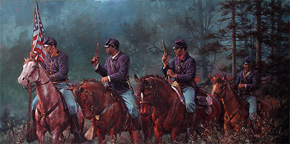 |
Civil War Battles |
|
State War Records |
| AL - AK - AZ - AR - CA - CO - CT - DE - FL - GA - HI - ID - IL - IN - IA - KS - KY - LA - MA - MD - ME - MI - MN - MS - MO - MT - NE - NV - NH - NJ - NM - NY - NC - ND - OH - OK - OR - PA - RI - SC - SD - TN - TX - UT - VT - VA - WA - WV - WI - WY |
The Battle of Saltville
October 2, 1864 in Saltville, Virginia
 |
|||||||||||||||||||||
|
Union cavalry and infantry raiders, led by Brig. Gen. Stephen Burbridge, attempted to destroy the saltworks near Saltville. He was delayed at Clinch Mountain and Laurel Gap by a makeshift Confederate force, enabling Brig. Gen. Alfred E. Jackson to concentrate troops near Saltville to meet him.
The Battle of Saltville began on the morning of October 2. Thomas Mays wrote, "A cold and foggy morning greeted both sides as they prepared for the impending struggle." The Confederate forces were strategically placed along the high river bluff back of the town (to the north), and northeast on the high ground. These positions were the key to the defense of Saltville. As the morning progressed, the Union troops were able to push the Confederate line back over Sander's Hill and towards Saltville.
At about 10:00 A.M., the Union troops began a series of dismounted charges upon Chestnut Ridge. Just beyond the Cedar Ridge lay the town of Saltville and the saltworks. Two small cavalry brigades commanded by Brig. Gen. Felix H. Robertson and Col. George Dibrell defended the ridge. The Union assaults were made on foot because of the unexpected strength of the Confederate position.
After 2 unsuccessful attempts, Lt. Col. Robert Ratliff’s Brigade made a final dismounted attack up the hill in an attempt to take Chestnut Ridge. This charge proved to be Burbridge’s last hope for victorWhen the Confederates observed that black soldiers were among the advancing brigade, the defenders became enraged. The sight of "their homeland being threatened by armed Negroes" was their greatest nightmare being realized.
The fury they displayed upon seeing the black soldiers enabled the defenders to stall the advance of Ratliff’s brigade. Eventually however, by force of numbers and the unexpected fighting prowess of the 5th USCC, the advancing Union force breached the Confederate line and was able to press the rebels to the top of the ridge. However, after six hours of fierce fighting, Ratliff’s Brigade was running perilously low on ammunition and was cut off from the rest of Burbridge’s forces and their supply line.
Confederate reinforcements continued to arrive throughout the day and the Southern lines around Saltville successfully repelled all Federal assaults. Ratliff’s cavalry continued to hold the Confederate works until nightfall, at which point, exhausted and out of ammunition, they pulled back from their advanced position.
At about 5:00 P.M., despite having made little headway after day long fighting, Burbridge retreated without accomplishing his objective. His retreat was hastened by news that Breckenridge had arrived with additional cavalry, though Burbridge still held a numerical troop advantage. Burbridge's retreating forces built bonfires to deceive the Confederates into thinking that they would remain, but in their haste to retreat they left most of their dead and wounded on the field.
Despite the outcome of the battle, their fellow soldiers lauded the performance of the 5th USCC during the assault of Chestnut Ridge. The Confederates were firing on them with grape and canister and were mowing them down by the scores but others kept straight on.
After day-long fighting, Burbridge retired without accomplishing his objective. Afterwards, Confederate soldiers were said to have murdered, captured, and wounded black soldiers.
A conservative estimate of the number of black murdered at Saltville is 46. Not only does Saltville stand as possibly the worst battlefield atrocity of the Civil War, it also demonstrates one of the factors that cause "rules of war" to break down. In warfare, as religion, race and culture conflict on the battlefield, the chance for a massacre of prisoners increases."
